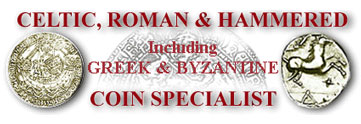A very brief historical introduction
Money used in the Eastern Roman Empire after the fall of the West is known as Byzantine currency and began with the monetary reform of Anastasius in 498. This currency consisted of the gold solidus and the bronze nummi (small bronzes). However by the end of the empire the currency was only issued in silver and copper. Early Byzantine coins portray the facing bust of the Emperor with usually a Christian symbol (cross, or a Victory/angel) on the reverse however the gold coins of Justinian II (first reign 685-695) have the bust of Christ on the obverse and a portrait of the Emperor on the reverse. New bronze coins, follis (larger bronzes) were introduced during Justinian I (ca.527) which featured a highly stylized portrait of the emperor while the reverse featured the value of the denomination represented according to the Greek numbering system (M=40, K=20, I=10, E=5). Silver coins were rarely produced.
The only regularly issued silver coin was the Hexagram first issued by Heraclius in 615 which lasted until the end of the 7th century. It was succeeded by the miliaresion established by Leo III ca.720, which became the standard issue from ca.830 on and until the late 11th century, when it was discontinued after being severely debased. Small transactions were conducted with bronze coinage throughout this period. In the 10th century, "anonymous folles" came along featuring the bust of Jesus on the obverse and the inscription "XRISTUS/bASILEU/bASILE", which translates to "Christ, Emperor of Emperors". The gold solidus or nomisma remained a standard of international commerce until the 11th century, when it began to be debased under successive emperors beginning in the 1030s under the emperor Romanos Argyros (1028-1034).
The Byzantine monetary system changed during the 7th century when the follis, now significantly smaller, became the only bronze coin to be regularly issued. Although Justinian II attempted a restoration of the follis size of Justinian I, the follis continued to slowly decrease in size. In the early 9th century the 11/12 weight coin was called a tetarteron and the full weight solidus was called the histamenon. The tetarteron was unpopular and was only sporadically reissued during the 10th century.
Former money changer Michael IV assumed the throne of Byzantium in 1034 and began debasing both the tetarteron nomisma and the histamenon nomisma. The debasement was gradual at first, but then accelerated rapidly until the first eleven years of the reign of Alexius I Comnenus (1081-1118) when the debased solidus (tetarteron and histamenon) was discontinued and a gold coinage of higher fineness was established, commonly called the hyperpyron. The hyperpyron was slightly smaller than the solidus. It was introduced along with the electrum aspron trachy.
During Andronicus II's reign (1183-1185) a new coinage based on the hyperpyron was issued. These scyphate (cup-shaped) coins known as trachy were issued in both electrum (debased gold) and billon (debased silver) and believed to be shaped this way for easier stacking. They remained in circulation until 1350s however during the last phase of Byzantine coinage in 1367, gold issues were discontinued and a regular silver issue was commenced.
After 1400, Byzantine coinage became insignificant, as Italian money became the predominant circulating coinage.

